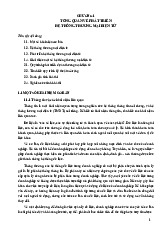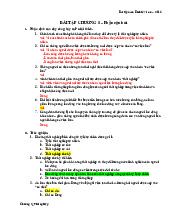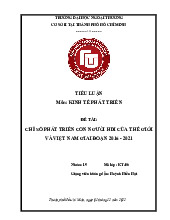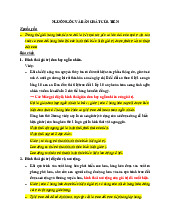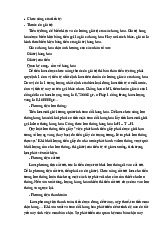






Preview text:
lOMoAR cPSD| 58562220 CORPORATE FINANCE
PRACTICE PROBLEMS FOR FINAL EXAM
1. If the correlation between two stocks is −1, the returns on the stocks:
correlation will quantify the strength and direction of linear relationship between 2 stocks
=> when one stock goes up, one will go down by a proportional amount. But the magnitude
of change may not be exactly the same. A. generally move in the same direction.
B. move perfectly opposite one another.
C. are unrelated to one another.
D. have standard deviations of equal size but opposite signs.
E. totally offset each other producing a rate of return of zero.
2. Which of the following values are squared values? variance measures the
average squared deviation, cái còn lại không biết tại sao
A. Variance, correlation, and covariance B. Variance and beta C. Covariance and variance
D. Correlation, beta, variance E. Covariance and correlation
3. The expected return on a portfolio is calculated as a(n) ____ average of the
expected returns on the individual securities held in the portfolio. weighted average
because formula use weight * return of each individual asset A. arithmetic B. weighted C. compounded D. geometric E. median
4. The expected return on a portfolio:
Cannot exceed its top performing asset and cannot be lower than its worst
A. can be greater than the expected return on the best performing security in the portfolio.
B. can be less than the expected return on the worst performing security in the portfolio.
C. is independent of the performance of the overall economy.
D. is limited by the returns on the individual securities within the portfolio.
E. is an arithmetic average of the returns of the individual securities when the weights of
those securities are unequal. Trung bình cộng là không phải là mỗi asset weight khác lOMoAR cPSD| 58562220
5. As we add more diverse securities to a portfolio, the ____ risks of the portfolio will decrease.
Unsystematic risk will decrease, but total risk = systematic + unsystematic => will also decrease A. total and systematic
B. systematic and unsystematic C. total and unsystematic D. unsystematic E. systematic
6. Which one of the following is an example of unsystematic risk?
Which event does not affect the entire market?
A. The inflation rate increases unexpectedly
B. The federal government lowers income taxes
C. An oil tanker runs aground and spills its cargo
D. Interest rates decline by .5 percent
E. A country's GDP rises by .5 percent more than anticipated
7. The principle of diversification tells us that:
Idiosyncratic risk = personal risk = unsystematic risk
A. concentrating an investment in two or three large stocks will eliminate all your risk.
B. concentrating an investment in three companies all within the same industry will greatly reduce your overall risk.
C. spreading an investment across five diverse companies will not lower your overall risk.
D. spreading an investment across many diverse assets will eliminate all the risk.
E. spreading an investment across many diverse assets will eliminate idiosyncratic risk.
8. The beta of a security is calculated by dividing the: Beta = Cov(Ri,Rm) / Var(Rm)
A. covariance of the security return with the market return by the variance of the market.
B. correlation of the security return with the market return by the variance of the market. C.
variance of the market by the covariance of the security return with the market return.
D. variance of the market return by the correlation of the security return with the market return.
E. covariance of the security return with the market return by the correlation of the security and market returns.
9. The market risk premium is computed by:
market returns = risk free return + risk premium
A. adding the risk-free rate of return to the inflation rate. lOMoAR cPSD| 58562220
B. adding the risk-free rate of return to the market rate of return.
C. subtracting the risk-free rate of return from the inflation rate.
D. subtracting the risk-free rate of return from the market rate of return.
E. multiplying the risk-free rate of return by the market beta. 10.
You recently purchased a stock that is expected to earn 12.6 percent in a booming
economy, 8.9 percent in a normal economy, and lose 5.2 percent in a recessionary economy.
Each economic state is equally likely to occur. What is your expected rate of return on this stock?
= ⅓ * 12.6% + ⅓ * 8.9% + ⅓ * -5.2% = A. 6.47% B. 8.90% C. 5.43% D. 7.65% E. 7.01% 11.
Stock A is expected to return 14 percent in a normal economy and lose 21 percent in a
recession. Stock B is expected to return 11 percent in a normal economy and 5 percent in a
recession. The probability of the economy being normal is 75 percent and being recessionary
is 25 percent. What is the covariance of these two securities?
ChatGPT tính ra kết quả giống cô. Nhưng tự tay tính lại thì ko có đáp án đấy.
Step 1: Calculate average return of A and B. = 5.25% and 9.5% respectively
Step 2: Use formula: of covariance = 0.00394 A. .007006 B. .006563 C. .005180 D. .007309 E. .006274
12. A portfolio is composed of 100 shares of Stock A valued at $22 each, 600 shares of Stock
B valued at $17 each, 400 shares of Stock C valued at $46 each, and 200 shares of Stock D
valued at $38 each. What is the portfolio weight of Stock C?
Step 1: Total value of portfolio = 100 * 22 + 600 *17 + 400 * 46 + 200 * 38 =38400
Step 2: weight of stock C = 400 * 46 / 38400 = 0.4792 A. 46.87% lOMoAR cPSD| 58562220 B. 48.09% C. 42.33% D. 45.27% E. 47.92%
13. The expected return on HiLo stock is 14.75 percent while the expected return on the
market is 13.7 percent. The beta of HiLo is 1.25. What is the risk-free rate of return?
CAPM: 14.75% = X + 1.25(13.7 - X) => X = 0.095 A. 1.05% B. 4.75% C. 10.75% D. 9.50% E. 2.33%
14. Countess Corporation is expected to pay an annual dividend of $4.15 on its common
stock in one year. The current stock price is $69.95 per share. The company announced that
it will increase its dividend by 3.35 percent annually. What is the company's cost of equity?
Cost of equity = D1 / P0 + growth rate = 4.15 / 69.95 + 3.35% = 0.0928 A. 9.85% B. 8.77% C. 9.02% D. 9.28% E. 9.48%
15. Galvatron Metals has a bond outstanding with a coupon rate of 6.7 percent and
semiannual payments. The bond currently sells for $1,863 and matures in 21 years. The par
value is $2,000 and the company's tax rate is 40 percent. What is the company's aftertax cost of debt? A. 4.67% B. 3.67% C. 3.43% D. 4.41% E. 4.07%
16. Further From Center has 10,500 shares of common stock outstanding at a price of $39
per share. It also has 230 shares of preferred stock outstanding at a price of $90 per share.
There are 550 bonds outstanding that have a coupon rate of 5.8 percent paid semiannually. lOMoAR cPSD| 58562220
The bonds mature in 20 years, have a face value of $1,000, and sell at 94.5 percent of par.
What is the capital structure weight of the preferred stock?
Step 1: Calculate the total value = 10500 * 39 +230 * 90 + 550 YTM of bond
Step 2: Weight of preferred stock = 230 * 90 / total value A. .4311 B. .5471 C. .0985 D. .0671E. .0218
17. Charlotte's Crochet Shoppe has 17,300 shares of common stock outstanding at a price per
share of $85 and a rate of return of 12.01 percent. The company also has 380 bonds
outstanding, with a par value of $2,000 per bond. The pretax cost of debt is 6.33 percent and
the bonds sell for 100.2 percent of par. What is the firm's WACC if the tax rate is 40 percent?
Step 1: Calculate the total value = 17300 * 85 + 380 * 2000 * 100.2% = 2232020
Step 2: Calculate the weight of equity = 17300 * 85 / 2232020 = 0.659
Step 3: Calculate the weight of debt = 1 - 0.659 = 0.341
Step 4: WACC = 0.341 * 6.33% (1-40%) + 0.659 * 12.01% = 0.09209 A. 8.89% B. 10.07% C. 9.21% D. 8.72% E. 10.51%
18. A firm should always select the capital structure that:
Managers always try to maximizes value of firm when capital structuring
A. produces the highest cost of capital.
B. maximizes the value of the firm. C. minimizes taxes.
D. maximizes current dividends. E. has no debt.
19. MM Proposition I without taxes proposes that:
If no Tax Shield, capital structure does not affect the company value whether levered or not
A. the value of an unlevered firm exceeds that of a levered firm.
B. there is one ideal capital structure for each firm.
C. leverage does not affect the value of the firm.
D. shareholder wealth is directly affected by the capital structure selected.
E. the value of a levered firm exceeds that of an unlevered firm. lOMoAR cPSD| 58562220
20. ________ are payouts of earnings, in the form of cash or stock, that are made to a firm’s owners.
Dividends = pay out of retained earnings to shareholders A. Dividends B. Distributions C. Share repurchases D. Payments-in-kind E. Stock splits
21. Assume a firm sells off some of its long-term assets and distributes the proceeds to its
owners. The cash payment to the owners is called a(n)
Just the definition of liquidating dividend. Firm sells capital to pay to shareholders as dividend A. Liquidating dividend. B. regular cash dividend. C. special dividend. D. extra cash dividend. E. share repurchase.
22. The last date on which an investor could purchase shares of stock and still receive the
dividend is the date _____ business day(s) prior to the date of record.
One business prior to the date of record = ex - dividend date.
Investors must buy stock before the ex-dividend date if they want to receive a dividend.
During that date, price of stock decrease A. zero B. one C. two D. five E. seven
23. Rosco’s has 15,000 shares of stock outstanding with a market price of $6 per share. What
will be the market price per share if the firm does a 1-for-3 reverse stock split?
15000 stocks becomes 5000 stocks. Price increase x3 A. $18 B. $24 C. $42 D. $48E. $54 lOMoAR cPSD| 58562220 24.
Assume you purchased 200 shares of Capricorn stock on March 15th. On March
20th, you purchased another 100 shares and then on March 22nd you purchased your final
200. The company declared a dividend of $1.10 per share on March 5th to holders of record
on Friday, March 23rd. The dividend is payable on March 31st. How much dividend income
will you receive on March 31st?
Purchase of stock in order to receive dividend must be 2 days prior to the record date. Record date = March 23rd A. $0 B. $220 C. $330 D. $440 E. $550 25.
Assume you own 300 shares of Sycamore stock. The firm plans on issuing a dividend
of $2.10 per share one year from today and then issuing a final liquidating dividend of
$36.45 per share two years from today. Your required rate of return is 14.5 percent. Ignoring
taxes, what is the value of one share of this stock to you today?
Discount it back. value today = 2.10 / 1.145 + 36.45 / 1.145^2 = A. $33.93 B. $29.64 C. $26.62 D. $27.80 E. $31.05
